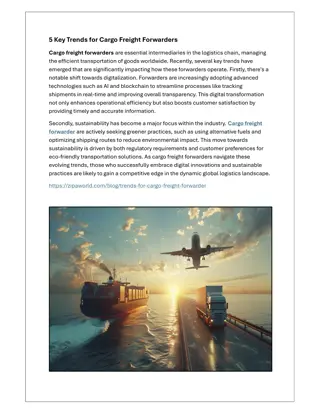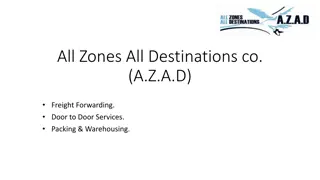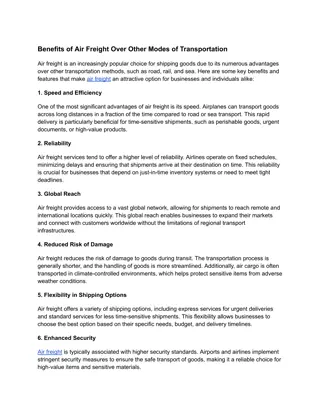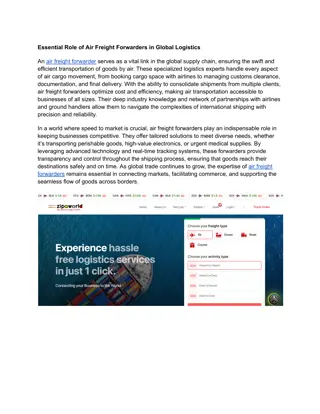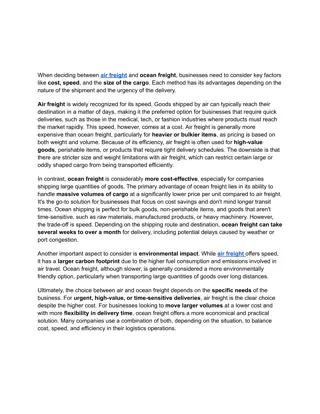
Emerging Trends in Air Freight- Future of Global Logistics
The air freight industry is experiencing significant transformations driven by technological advancements, sustainability initiatives, and the surge in e-commerce. Digital transformation is at the forefront, with blockchain technology enhancing trans
Download Presentation

Please find below an Image/Link to download the presentation.
The content on the website is provided AS IS for your information and personal use only. It may not be sold, licensed, or shared on other websites without obtaining consent from the author. If you encounter any issues during the download, it is possible that the publisher has removed the file from their server.
You are allowed to download the files provided on this website for personal or commercial use, subject to the condition that they are used lawfully. All files are the property of their respective owners.
The content on the website is provided AS IS for your information and personal use only. It may not be sold, licensed, or shared on other websites without obtaining consent from the author.
E N D
Presentation Transcript
Emerging Trends in Air Freight- Future of Global Logistics The air freight industry is undergoing significant transformations driven by technological advancements, changing market dynamics, and evolving customer expectations. Staying ahead of these trends is crucial for logistics companies aiming to maintain a competitive edge and deliver exceptional service. Here s a look at some of the key trends shaping the future of air freight. 1. Digital Transformation and Automation Blockchain Technology: Enhances transparency, security, and efficiency in tracking shipments, reducing paperwork and minimizing fraud. Artificial Intelligence (AI): AI-powered predictive analytics improve demand forecasting, optimize routes, and enhance capacity utilization. Internet of Things (IoT): IoT devices provide real-time data on cargo conditions, ensuring better monitoring and management of perishable and sensitive goods. 2. Sustainability Initiatives Carbon Neutrality: Increasing emphasis on reducing carbon footprints through carbon offset programs and sustainable fuel alternatives. Eco-Friendly Practices: Airlines are investing in fuel-efficient aircraft and adopting green logistics practices to meet environmental regulations and consumer expectations. 3. E-commerce and Global Trade Growth E-commerce Boom: The surge in online shopping has increased the demand for rapid and reliable air freight services, necessitating improvements in speed and efficiency. Cross-Border Trade: Expansion of global markets drives the need for robust international air freight networks to handle diverse and growing trade volumes. 4. Advanced Security Measures Enhanced Screening: Implementation of advanced screening technologies to ensure cargo security and compliance with international regulations. Cybersecurity: Strengthening cybersecurity measures to protect sensitive data and prevent disruptions in supply chain operations. 5. Flexible and Resilient Supply Chains Agility in Operations: Developing flexible logistics solutions to quickly adapt to market fluctuations, disruptions, and changing customer demands. Resilience Planning: Emphasizing resilience in supply chains to manage risks associated with geopolitical tensions, natural disasters, and pandemics.
6. Data-Driven Decision Making Big Data Analytics: Leveraging big data to gain insights into market trends, customer preferences, and operational efficiencies. Real-Time Tracking: Utilizing real-time tracking technologies to provide customers with accurate and timely updates on their shipments. Conclusion The air freight industry is rapidly evolving, driven by technological innovations, a focus on sustainability, and the growing demands of e-commerce and global trade. Embracing digital transformation, enhancing security measures, and developing flexible, resilient supply chains are essential for staying competitive in this dynamic landscape. By keeping abreast of these trends and integrating them into their operations, logistics companies can ensure efficient, secure, and sustainable air freight services that meet the ever-changing needs of the global market.




